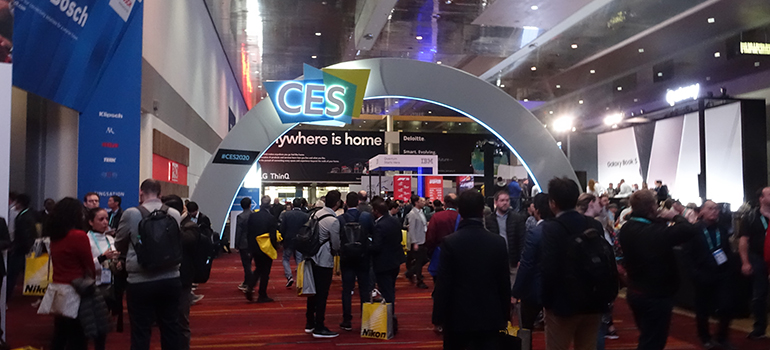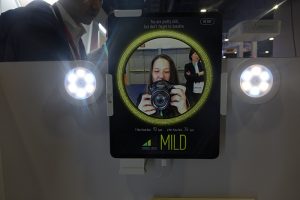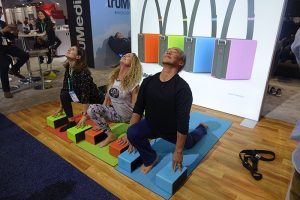I have been attending the annual Consumer Electronics (CES ) trade show since 2002. And while many long-time show-goers criticize how much the event has changed and the scope widened over the years, and first-time attendees find it pointless because so much can be accomplished remotely in this day and age, I will really miss going this year.

I have to hand it to the Consumer Technology Association (CTA), organizers and producers of CES, for pivoting so quickly to offer a full digital event this year due to the COVID-19 pandemic. Regrettably, it was the only option. CES is an important event and the wonder it brings to the industry is needed more than ever this year. How will it all go? Events commence the week of January 11, 2021, so it’s too early to tell. But I’m admittedly not as excited about the virtual show as I probably should be.
Preparing for the Show
Every year around Halloween, the pitches start flooding in for CES, which takes place annually in early January. Major tech companies reveal details about hot, new tech they’ll be showcasing in their flashy booths, from OLED TVs to large appliances, hifi headphones, and more. Meanwhile, innovative start-ups try to get the media’s attention through unique gadgets and gear: I have seen everything from baseball caps with customizable LED screens to electronic lunchboxes, toilet paper delivery robots, and even a fork that buzzes if you eat too much, too quickly.
By November, I’m usually fully booked for the show, which is always a grueling process. Finding the right combination of affordable and nicely timed flights with a hotel room on the Las Vegas Strip that won’t break the bank has become increasingly difficult over the years. That’s another reason many people loathe going to the show and might even be secretly sighing of relief that they don’t have to endure it all this year.
For 2021, preparing for CES didn’t cost me a dime. While I am still doing the same research prep, RSVP’ing for events, and creating a schedule, I don’t have to worry about travel beyond going from my bedroom to my home office in the basement. I don’t have to bring multiple chargers to keep my computer and smartphone juiced up at all times. I don’t have to get U.S. cash. I don’t have to pack. Logistics is simple.
Attending the Show
Usually, once I arrive in Las Vegas, the action-packed schedule begins shortly after checking into my hotel room and grabbing my badge. Things kick off with the CES Unveiled pre-show evening event then start from the early morning hours on Press Day to a late night at the Pepcom Media event. Lather, rinse, repeat through to the end of the show. Each day is filled with press conferences, furious writing in the press room and back in my hotel room, walking the show, booth tours, meetings, demos, after-hours events, and more. Somewhere in that week, I manage to squeeze in a few hours of sleep per night.
This year, I’ll be logging on to various conferences and events from the comfort of my home. The late nights will be gone as will the hangovers, the sore feet and back, and clobbering my daily step goals.
This won’t be the first time I “attend” a CES press conference virtually. Admittedly, every year there’s at least one press conference that I watch via livestream or on a screen in an overflow room because the main room is already full (if you don’t get in line at least an hour ahead for the majors or have a VIP press pass, you’re out of luck). But watching the livestream from my computer has always been a last resort, not the only option.
Feelings on the Virtual Show
As much as show-goers complain about the massive crowds, line-ups for just about everything, unhealthy food, excessive drinking, ’round the clock schedules and extreme exhaustion that follows, being at CES in person adds a “wow” factor, a level of energy that can’t be matched online.
 Being present in Las Vegas isn’t just about seeing all of the hoopla surrounding product launches, from LG’s impressive hallway display of synced OLED panels to actors running on treadmills demonstrating fitness gear, enthusiastic spokespersons touting the benefits of their new technology, and robots curiously roaming around. (Though these are a sight to see.) It’s about being able to touch, feel, listen to, see, and enjoy products and innovations in person.
Being present in Las Vegas isn’t just about seeing all of the hoopla surrounding product launches, from LG’s impressive hallway display of synced OLED panels to actors running on treadmills demonstrating fitness gear, enthusiastic spokespersons touting the benefits of their new technology, and robots curiously roaming around. (Though these are a sight to see.) It’s about being able to touch, feel, listen to, see, and enjoy products and innovations in person.
 I’ve boxed against a machine on the show floor, sat inside a flying car, participated in virtual reality demos, tested out facial recognition software, and got my phone’s screen cleaned. Seeing televisions up close is the only way to truly understand the wonder of the gorgeous pictures and demoing headphones and speakers in a controlled environment is what really gets the message across about the quality of sound. From a journalist’s perspective, trying out fun products in person is makes convinces you that they’re worth writing about.
I’ve boxed against a machine on the show floor, sat inside a flying car, participated in virtual reality demos, tested out facial recognition software, and got my phone’s screen cleaned. Seeing televisions up close is the only way to truly understand the wonder of the gorgeous pictures and demoing headphones and speakers in a controlled environment is what really gets the message across about the quality of sound. From a journalist’s perspective, trying out fun products in person is makes convinces you that they’re worth writing about.
I can watch videos to learn about all of these products. But it’s not the same. A web link or video isn’t going to grab my attention or provide the same energy as a crowd of people around a booth or a demo in the walkway.
 Then, there’s the Eureka Hall exhibits, where innovative start-ups from all around the world convene. I always dedicate the last day of the show to navigating this massive area, following my gut instinct as I walk around to decide what booths to visit. A product can’t really catch my eye online like it would in person.
Then, there’s the Eureka Hall exhibits, where innovative start-ups from all around the world convene. I always dedicate the last day of the show to navigating this massive area, following my gut instinct as I walk around to decide what booths to visit. A product can’t really catch my eye online like it would in person.
The social aspect of an event like CES can’t be discounted either. A Zoom call or virtual meeting is not the same as seeing colleagues and friends in person. Sharing thoughts and insights about the show over a cup of coffee or cab ride over to the Convention Center in the morning or discussing the latest technology and innovations over a glass of wine or while munching on delectable treats in a hotel suite, is so valuable. From a business perspective, the opportunity for deals to be made on the show floor or while sipping beers at the hotel bar at 10 p.m. is all but gone.
Attending But Still Missing CES
Will I be “attending” CES this year? Yes, absolutely. Am I excited about it? Not like I normally would be. Yes, I will see familiar faces through my computer screen. I will learn about new products and technologies, and maybe even see demonstrations live online. Everything will be conveniently in one place. But it won’t be the same.
I will miss the fact that my feet won’t be aching from walking 25,000 steps per day across the different halls of the Las Vegas Convention Center, along the Las Vegas Strip, and within various hotels. I will miss that I won’t be consuming far too much alcohol, popping $20 into a slot machine on the way back to my room in hopes of getting three 777s, and meeting fellow journalists and industry members for after-work drinks. I will miss not kicking my feet up at the end of the night in a stale-smelling hotel room and waiting impatiently in line for 15 minutes every morning for a coffee from Starbucks. I’d give anything to walk through a noisy, cigarette-smelling Las Vegas hotel at 1 a.m. in three-inch heels, exhausted and spent, but ready to do it all over again the next day.
Regardless of the format and the concessions that have to be made for 2021, CES will serve its purpose: to inform the industry about new and upcoming products and technologies and company roadmaps for the upcoming year, help start-ups find investors, foster deals between retailers, e-tailers, and manufacturers/distributors, generate tons of press, and get people excited for the future of technology. But chances are that if the original in-person show format returns for CES 2022 (fingers crossed), attendance will sky-rocket, complaints will be fewer and farther between, and hand sanitizer will be in abundance more than ever.




Hi Christine
I guess this years CES have to be a special one this year. However it might also be a possibility for the companies to show how they have pushed the limits for what can be done remotely/digital the last 10 months.
Lets hope that CES 2022 will be a more normal one where people can meet in real life. After all that is what we all want.